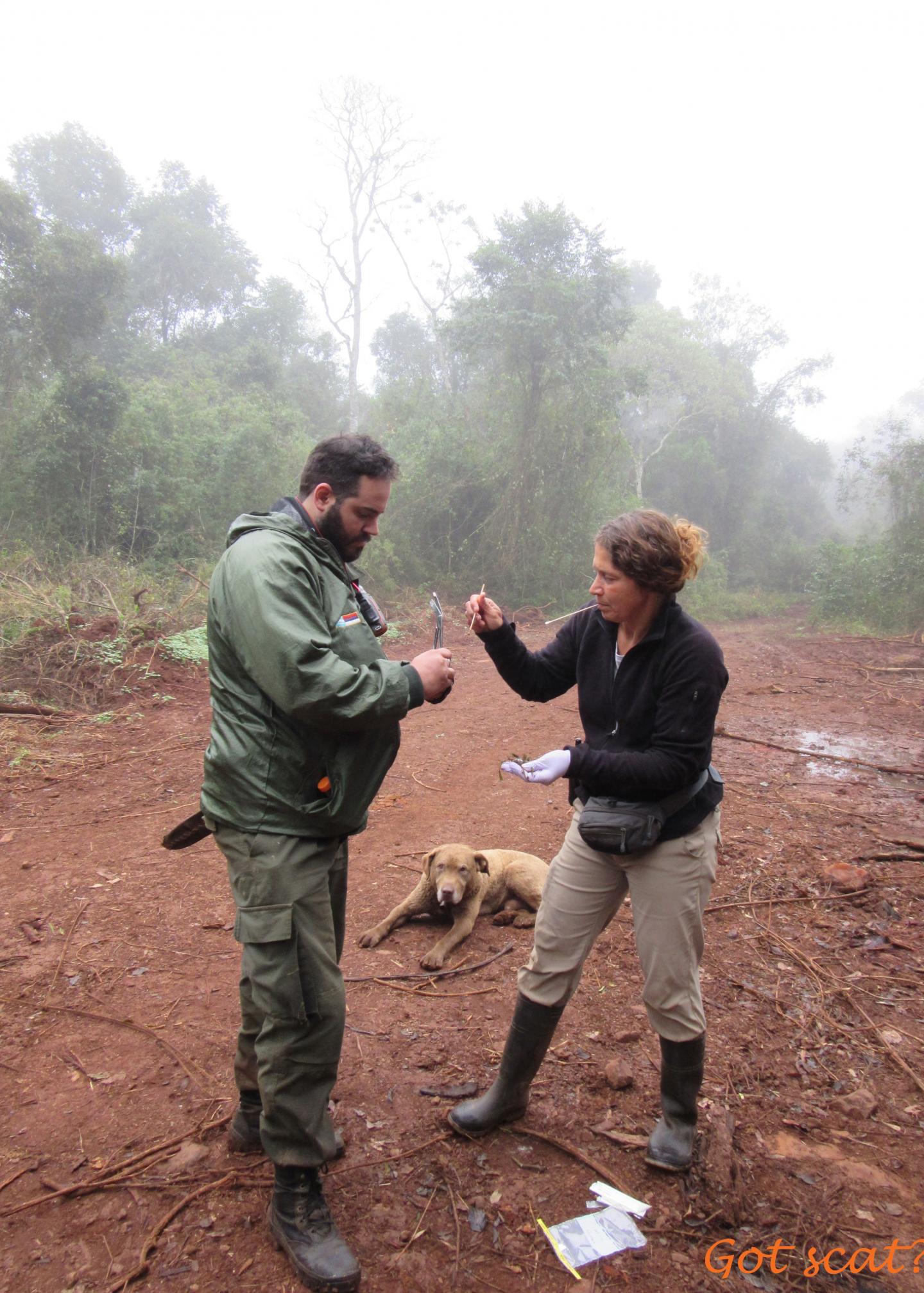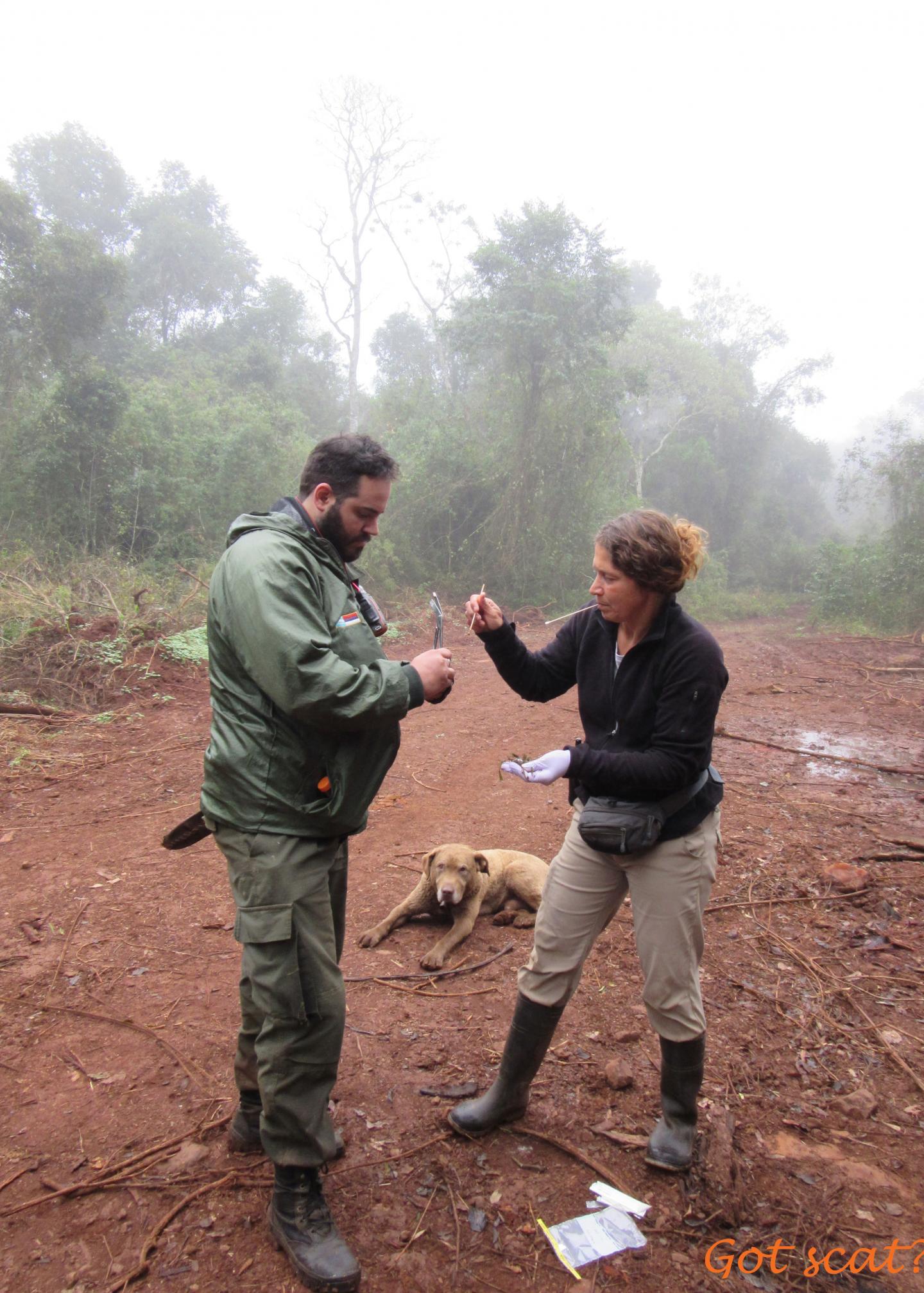
Credit: Photo: Courtesy of Karen DeMatteo
Scat-sniffing research dogs are helping scientists map out a plan to save reclusive jaguars, pumas, bush dogs and other endangered carnivores in the increasingly fragmented forests of northeastern Argentina, according to a new study from Washington University in St. Louis.
Published Aug. 25 in the online journal PLOS ONE, the study explores options for mitigating the impact of human encroachment on five predators who cling to survival in isolated pockets of protected forest surrounded by a mosaic of roadways, unprotected forest, plantations and pastures.
"The study details a least-cost plan for the development of a multispecies biological corridor that connects protected areas in the Upper Parana Atlantic Forest Region of Misiones, Argentina," said co-author Karen DeMatteo, a biology research scientist and lecturer in environmental studies in Arts & Sciences.
DeMatteo, who has spent 10 years working on the project, said completion of the corridor model will allow researchers and community leaders to begin working with property owners to establish the habitat corridors.
"This plan is exciting not only for the future of the local biodiversity, but also because it involved a lot of collaboration from the local government and universities to make it happen," she said.
Recent studies have argued that establishing small, protected reserves for endangered species, even in the best of habitats, is not enough to ensure long-term survival because species must move across their range to breed with other scattered populations and maintain genetic diversity.
Using dogs trained to detect the scat of specific species, DeMatteo's team searched for evidence of the carnivores' presence across a broad swath of northeastern Argentina, including public and private wildlife reserves, privately owned plantations, farms and pastures, and along roads and pathways leading to scattered communities.
DNA analysis of more than 900 scat samples collected over several summers allowed researchers to develop detailed maps of the species frequenting these habitats, including a sense of how their movements were influenced by habitat quality, topography, roadways and other human disturbances.
For species such as the jaguar, which rarely crosses into territory disturbed by humans, survival may hinge on the creation of habitat corridors linking isolated population pockets. Because the jaguar is so averse to human interaction, some studies have suggested that habitat corridors designed for it also would cover the needs of other predators.
DeMatteo's study, which examined the habitat needs of jaguars, pumas, ocelots, oncillas and bush dogs, offers a more nuanced approach, suggesting that the optimal footprint for habitat corridors should be drawn with the overlapping needs of many species in mind.
While some species were less intimidated by the presence of humans, each had its own unique requirements in terms of what constitutes a suitable habitat and the length and width of possible corridor connections.
"Despite variation in body size, the jaguar, puma, ocelot, oncilla and bush dog overlap in their ecological requirements," the study said. "However, this is not without variation in the degree of habitat flexibility. Puma, oncilla, and bush dog have comparatively higher levels of modified habitats in their potential distributions compared to the jaguar and ocelot."
By combining data on all five of these species, researchers developed a model that provides maximum habitat connectivity for all species while minimizing the cost of establishing these corridors through privately owned lands and communities.
"The findings illustrate the benefit of using multiple species versus a single species to develop corridors, because using only the highly restricted jaguar to develop the corridor would mean that the potential distributions of the other four carnivores would be restricted and decreased by as much as 30 percent," DeMatteo said. "So, it appears that, at least in the Misiones province, the jaguar should not be modeled as an umbrella species because the results fail to capture the varied requirements of coexisting species across the breadth of potential habitats."
DeMatteo and colleagues hope the study provides a methodology for identifying the optimal footprint for proposed habitat connection corridors, while incorporating enough flexibility to ensure that the needs and desires of private landholders can be incorporated into the process.
"The approach in making a corridor a reality is multi-pronged and involves a strong investment from the local community, especially when developing corridors that use existing protected areas as 'stepping stones,' as private land will inevitably be involved to varying degrees in and around the corridor," the study concludes.
###
Co-authors on the study are Miguel A. Rinas, Juan Pablo Zurano, Nicole Selleski, Rosio G. Schneider and Carina F. Argüelles, whose affiliations include Universidad Nacional de Misiones, Instituto de Biología Subtropical, Grupo de Investigación en Genética Aplicada and Ministerio de Ecología.
Funding was provided by the Conservation, Food & Health Foundation, National Geographic Society Conservation Trust, the Palm Beach Zoo Conservation Fund, a University of Missouri-St. Louis Research Award, the Zoological Gardens of Chester-North of England Zoological Society Conservation and Research Fund, the Jaguar Conservation Fund-Woodland Park Zoo, Phoenix Zoo Conservation & Science Program, Fresno Chaffee Zoo Wildlife Conservation Fund, Kickstarter Fund, Paris Zooand Riverbanks Conservation Support Fund.
Media Contact
Gerry Everding
[email protected]
314-935-6375
@WUSTLnews
Home
Original Source
https://source.wustl.edu/2017/09/scat/ http://dx.doi.org/10.1371/journal.pone.0183648





